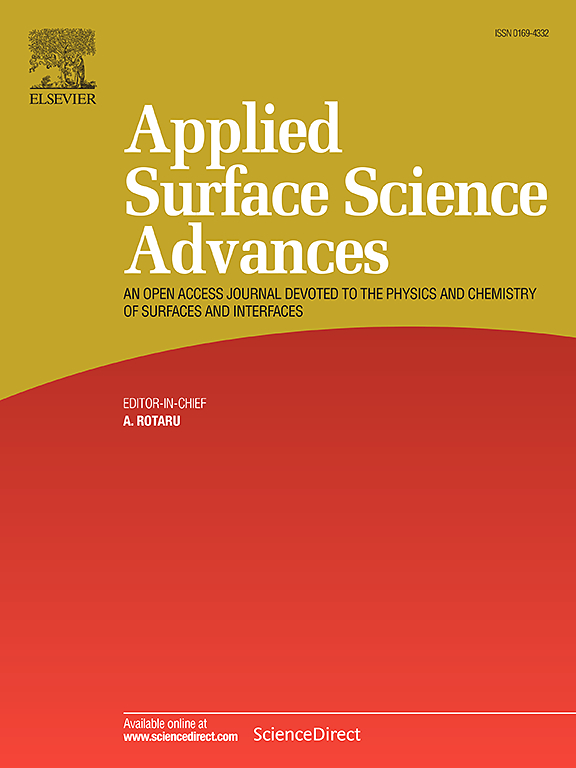Preparation and characterization of silver-doped, zinc-doped, and silver-zinc co-doped β-tricalcium phosphate/barium titanate/collagen composite scaffolds
IF 8.7
Q1 CHEMISTRY, PHYSICAL
引用次数: 0
Abstract
To overcome the disadvantage of lacking antibacterial properties for beta-tricalcium phosphate (β-TCP), the Ag, Zn, or Ag/Zn-doped powders were synthesized using spray pyrolysis. Afterward, by adding barium titanate (BT) and collagen (COL), a freeze-drying method was applied to prepare pure β-TCP/BT/COL and metal (Ag, Zn, or Ag/Zn)-doped β-TCP/BT/COL composite scaffolds. In this study, the morphologies, phase compositions, porosities, mechanical properties, antibacterial properties, and cell viabilities of composite scaffolds were characterized by X-ray diffraction, scanning electron microscopy, mercury porosimeter, universal testing machine, antibacterial test, and 3-(4,5-dimethylthiazol-2-yl)-2,5-diphenyltetrazolium bromide assay, respectively. Among these scaffolds, unlike the single metal-doped β-TCP scaffolds (e.g., Ag-doped β-TCP/BT/COL scaffolds or Zn-doped β-TCP/BT/COL scaffolds), the Ag/Zn co-doped β-TCP/BT/COL scaffolds offer the excellent antibacterial properties of ∼99.65 % against Escherichia coli and exhibit the superior cell viability of ∼94.59 % against MC3T3-E1 cells. Additionally, the Ag/Zn co-doped scaffolds showed enhanced compressive strength and maintained an interconnected porous architecture favorable for osteointegration. These results suggest that co-doping with Ag and Zn not only imparts strong antibacterial activity but also improves the biological and mechanical performance of the scaffolds. Therefore, the Ag/Zn co-doped β-TCP/BT/COL scaffold presents a promising multi-functional material for future applications in bone tissue engineering.
银掺杂、锌掺杂、银锌共掺杂β-磷酸三钙/钛酸钡/胶原复合支架的制备与表征
为了克服β-磷酸三钙(β-TCP)缺乏抗菌性能的缺点,采用喷雾热解法制备了Ag、Zn或Ag/Zn掺杂粉末。然后,通过添加钛酸钡(BT)和胶原蛋白(COL),采用冷冻干燥的方法制备纯β-TCP/BT/COL和金属(Ag、Zn或Ag/Zn)掺杂的β-TCP/BT/COL复合支架。本研究采用x射线衍射、扫描电镜、汞孔计、万能试验机、抗菌试验和3-(4,5-二甲基噻唑-2-基)-2,5-二苯基溴化四唑试验分别对复合支架的形貌、相组成、孔隙率、力学性能、抗菌性能和细胞活力进行了表征。在这些支架中,与单金属掺杂的β-TCP支架(例如Ag掺杂的β-TCP/BT/COL支架或Zn掺杂的β-TCP/BT/COL支架)不同,Ag/Zn共掺杂的β-TCP/BT/COL支架对大肠杆菌的抗菌性能为~ 99.65%,对MC3T3-E1细胞的细胞存活率为~ 94.59%。此外,Ag/Zn共掺杂支架显示出增强的抗压强度,并保持有利于骨整合的互联多孔结构。结果表明,Ag和Zn的共掺杂不仅具有较强的抗菌活性,而且提高了支架的生物学和力学性能。因此,Ag/Zn共掺杂β-TCP/BT/COL支架在骨组织工程中具有广阔的应用前景。
本文章由计算机程序翻译,如有差异,请以英文原文为准。
求助全文
约1分钟内获得全文
求助全文

 求助内容:
求助内容: 应助结果提醒方式:
应助结果提醒方式:


